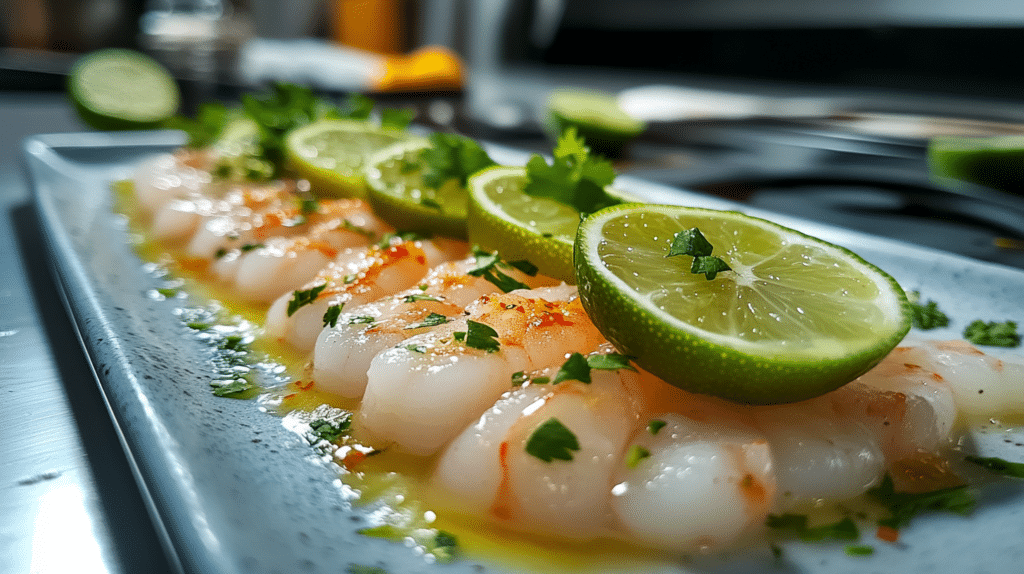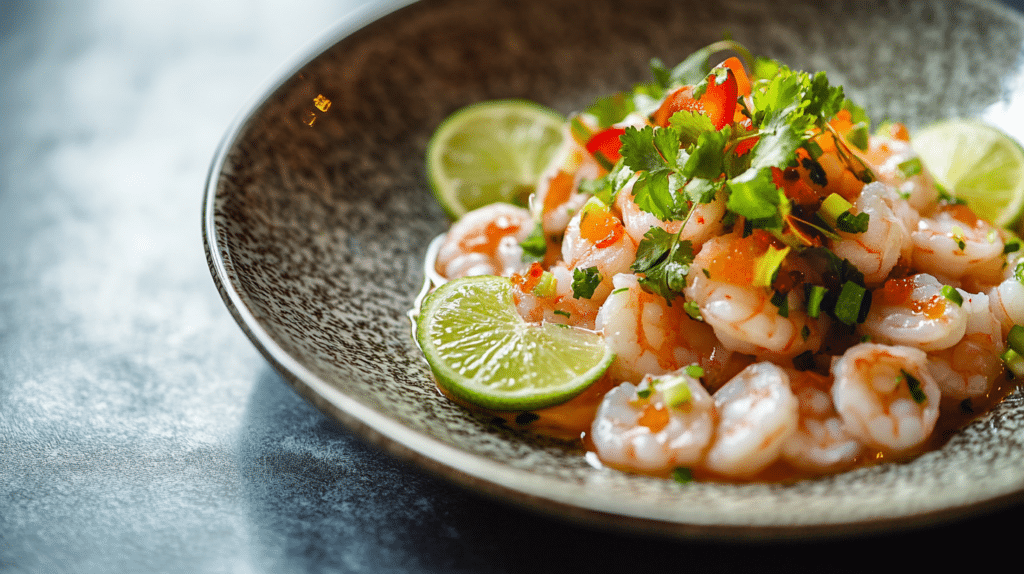Raw shrimp is a widely appreciated seafood delicacy, celebrated in cuisines across the globe for its natural sweetness, tender texture, and versatility. Whether featured in sushi, ceviche, or other culinary creations, it holds a special place in dishes that highlight fresh, high-quality ingredients. From its sweet flavor to its unique firm texture, raw shrimp plays a key role in dishes like sushi, ceviche, and shrimp tartare. However, preparing and consuming shrimp requires attention to detail, ensuring it is safe and delicious. This comprehensive guide covers everything you need to know about raw shrimp, from safety tips to preparation techniques and more.
Table of contents
What Is Raw Shrimp?
Raw shrimp refers to shrimp that has not been cooked or processed using heat. Instead, it is served as-is or in dishes where it is lightly “cooked” through techniques like marination in citrus juices. This method, often used in ceviche, allows the shrimp to retain its natural flavor and texture. But what makes raw shrimp such a sought-after ingredient in global cuisines?
Natural Sweetness
Raw shrimp showcases a delicate, sweet flavor that is often masked when cooked. This natural sweetness pairs perfectly with simple accompaniments like citrus, soy sauce, or light herbs, allowing the shrimp’s unique taste to be the highlight of the dish.
Unique Texture
The texture of raw shrimp is a key reason it is loved by many. It is slightly firm yet tender, with a translucent appearance that makes it visually appealing. This texture is especially prized in dishes like sushi and sashimi, where presentation matters as much as taste.
Versatility Across Cuisines
Raw shrimp is used in a wide range of dishes, reflecting its versatility:
- Sushi and Sashimi: A staple in Japanese cuisine, often paired with soy sauce, wasabi, and pickled ginger.
- Ceviche: A zesty Latin American dish where raw shrimp is marinated in lime or lemon juice, giving it a refreshing and tangy flavor.
- Fusion Dishes: Creative chefs use raw shrimp in salads, carpaccio, or even tacos for a unique twist.
Shrimp isn’t just confined to raw preparations—it shines in a variety of recipes, both raw and cooked. For an excellent cooked option, consider trying recipes like the Cajun Shrimp Alfredo for a bold and creamy dish that highlights the shrimp’s versatility.

The Nutritional Benefits of Raw Shrimp
Shrimp isn’t just delicious—it’s packed with nutrients that make it a smart choice for a healthy diet. Whether you’re enjoying it raw in sushi or ceviche, shrimp delivers a wide range of health benefits. Here’s why it’s considered a nutritional powerhouse:
High-Quality Protein
Shrimp is an excellent source of protein, which is essential for building and repairing muscles. Just a small serving can provide a significant portion of your daily protein needs, making it ideal for athletes, growing children, or anyone looking to maintain strong muscles.
Low in Calories
For those watching their calorie intake, shrimp is a fantastic option. It’s naturally low in calories while still being filling and satisfying. This makes it a great addition to weight management diets or light meals without compromising on flavor or nutrition.
Rich in Omega-3 Fatty Acids
Shrimp is a great source of omega-3 fatty acids, which are important for keeping your heart and brain healthy. These healthy fats can lower swelling in your body, help your brain work better, and reduce the chance of heart problems. Adding shrimp to your meals is an easy and delicious way to get more of these important nutrients.
Packed with Key Vitamins and Minerals
Raw shrimp is loaded with essential nutrients, including:
- Selenium: A powerful antioxidant that helps protect your cells from damage.
- Vitamin B12: Vital for maintaining energy levels and supporting nerve health.
- Iodine: Important for thyroid function and regulating your body’s metabolism.
These nutrients are crucial for overall health and can help support everything from your immune system to your energy levels.
Why Raw Shrimp is a Great Choice
When prepared and handled properly, raw shrimp retains its full nutritional value. Unlike some cooking methods that can diminish certain vitamins or change the fat profile, eating shrimp allows you to enjoy all its health benefits in their most natural state. Plus, raw shrimp is incredibly versatile, fitting seamlessly into a variety of light, nutrient-rich dishes.
Whether you’re adding it to a refreshing ceviche or enjoying it as part of a sashimi platter, raw shrimp offers a unique blend of flavor and nutrition. It’s a simple yet effective way to nourish your body while delighting your taste buds.ly, raw shrimp retains its nutritional value and contributes to a balanced diet. If you’re looking for ways to incorporate shrimp into a diverse menu, try the Best Chicken and Shrimp Dishes Recipes for Every Occasion.
Is It Safe to Eat Raw Shrimp?
Eating raw shrimp is safe if the proper precautions are taken. Here’s what you need to know:
Risks of Eating Raw Shrimp
Raw shrimp can harbor bacteria like Vibrio or Salmonella and parasites. Without proper sourcing and preparation, consuming raw shrimp may lead to foodborne illnesses.
How to Ensure Safety
- Source from Trusted Suppliers: Buy shrimp labeled as sushi-grade or certified for raw consumption.
- Freeze Shrimp Before Use: Freezing kills parasites that might be present in raw shrimp.
- Inspect for Freshness: Fresh shrimp should have a translucent appearance and a clean ocean smell.
If you prefer cooked shrimp recipes, try the Best Lobster Ravioli Sauces, which feature creamy and butter-based options to complement shrimp dishes.
How to Prepare Raw Shrimp at Home
Preparing raw shrimp at home might seem daunting, but it’s straightforward if you follow these steps:
Clean the Shrimp
- Rinse the shrimp under cold running water.
- Remove the shell, leaving the tail intact if desired for presentation.
Devein the Shrimp
- Use a small knife to cut along the back of the shrimp.
- Remove the dark vein carefully to improve texture and presentation.
Inspect for Quality
- Check for firmness and a mild ocean smell.
- Avoid shrimp with a mushy texture or strong odor.
Prepared raw shrimp can be used in sushi rolls, ceviche, or even shrimp carpaccio. Pairing raw shrimp with light sauces or citrus juices can enhance its natural sweetness and texture.

Cultural Dishes Featuring Raw Shrimp
Raw shrimp plays a starring role in many cuisines across the globe, each highlighting its unique flavor and versatility. From Asia to Latin America to Europe, cultures have developed dishes that celebrate the sweetness and tender texture of this seafood delicacy.
Sushi and Sashimi (Japan)
In Japanese cuisine, raw shrimp is a prized ingredient in sushi and sashimi. The shrimp is often served:
- Paired with soy sauce for savory depth.
- With wasabi to add a touch of heat.
- Alongside pickled ginger to cleanse the palate between bites.
The simplicity of preparation allows the shrimp’s natural sweetness and firm texture to shine. Raw shrimp sushi, known as amaebi (sweet shrimp), is particularly popular for its melt-in-your-mouth tenderness.
Ceviche (Latin America)
Ceviche is a vibrant dish that transforms raw shrimp into a tangy, refreshing treat. The shrimp is marinated in citrus juices, typically lime or lemon, which “cooks” the shrimp through acidity.
- Additional ingredients like cilantro, onions, and chili peppers create a balance of fresh, spicy, and zesty flavors.
- Common accompaniments include tostadas, tortilla chips, or avocado slices.
Ceviche is a favorite in coastal regions and is often enjoyed as a light appetizer or a flavorful main dish.
Shrimp Tartare (Europe)
Shrimp tartare is a refined European dish that showcases the versatility of shrimp. The shrimp is finely chopped and blended with:
- Olive oil for richness.
- Lemon juice for a bright, citrusy touch.
- Herbs such as parsley or dill for freshness.
- Spices like cracked black pepper or paprika for a subtle kick.
Often served with toasted bread or crackers, shrimp tartare makes for an elegant appetizer that impresses with its delicate flavors.
Additional Regional Dishes
Raw shrimp also appears in other regional delicacies:
Korean Hoe: A sashimi-style preparation where raw shrimp is served with dipping sauces like soy sauce or chili paste.
Thai Goong Chae Nam Pla: A spicy Thai dish featuring raw shrimp marinated in fish sauce, lime juice, and garlic, served with herbs and chili.
FAQs
Can You Eat Raw Shrimp Safely?
Yes, you can eat raw shrimp safely, but there are a few important rules to follow:
- Always buy shrimp that is fresh and labeled as sushi-grade or safe for raw consumption.
- Ensure the shrimp is properly handled and stored. Keeping it cold and clean is key to avoiding contamination.
- Source your shrimp from a trusted supplier to ensure it has been handled with care.
Taking these steps minimizes risks and allows you to enjoy raw shrimp with confidence.
What Happens if You Eat Contaminated Raw Shrimp?
Eating contaminated shrimp can lead to foodborne illnesses. Common symptoms include:
- Nausea and vomiting.
- Stomach cramps or pain.
- Diarrhea or other digestive discomfort.
Freezing shrimp before consuming it raw helps kill most parasites. Proper cleaning and preparation can also reduce the risk of bacteria. If you feel unwell after eating shrimp, it’s important to consult a doctor promptly.
How Do You Prepare Shrimp for Raw Dishes?
Preparing shrimp for raw dishes requires care and attention. Follow these steps for safe and delicious results:
- Clean the Shrimp Thoroughly: Rinse under cold water to remove any dirt or debris.
- Devein the Shrimp: Use a small knife to remove the dark vein along the back of the shrimp. This improves both texture and appearance.
- Inspect for Freshness: Fresh shrimp should have a translucent look and a mild, ocean-like smell. Avoid shrimp with a slimy texture or a strong, fishy odor.
- Serve Immediately: Raw shrimp is best served fresh to ensure both flavor and safety.
With these steps, you can confidently prepare shrimp for dishes like sushi or ceviche.
What Are the Best Dishes for Raw Shrimp?
Raw shrimp is incredibly versatile and shines in many dishes. Here are a few favorites:
- Ceviche: Shrimp marinated in citrus juices, often mixed with fresh herbs, onions, and peppers for a zesty, refreshing dish.
- Sushi and Sashimi: Thinly sliced shrimp served with soy sauce, wasabi, and pickled ginger, showcasing its natural sweetness.
- Shrimp Tartare: Finely chopped shrimp blended with olive oil, lemon, and herbs, creating a sophisticated appetizer.
Each of these dishes highlights the unique texture and flavor of shrimp, making it a standout ingredient in global cuisines.
Final Thoughts
Shrimp is more than just an ingredient; it’s a culinary treasure that embodies simplicity and flavor. When handled and prepared correctly, this seafood delicacy can transform dishes, offering a unique balance of sweetness, tenderness, and versatility. From its starring role in traditional sushi rolls to the tangy brilliance of ceviche, shrimp shines as a centerpiece in diverse cuisines.
Its adaptability allows it to pair with bold, spicy marinades just as easily as it complements delicate citrus and herb dressings. Whether you’re serving it as part of an elegant tartare or exploring creative dishes like Thai Goong Chae Nam Pla, shrimp delivers endless culinary possibilities.
However, the key to enjoying this seafood lies in careful preparation. By sourcing fresh, high-quality ingredients and following proper handling techniques, you ensure both safety and flavor. Steps like freezing, cleaning, and meticulous inspection are essential when preparing seafood dishes at home.
For those who want to explore beyond raw preparations, consider trying recipes like Chicken Marsala Fettuccine. This hearty dish combines the rich flavors of shrimp with pasta, adding variety and depth to your menu.
In every preparation—raw or cooked—shrimp remains a versatile, crowd-pleasing ingredient that never fails to impress. Whether you’re an experienced chef or a curious home cook, it invites you to discover new flavors and culinary techniques, showcasing the best of global cuisine.

